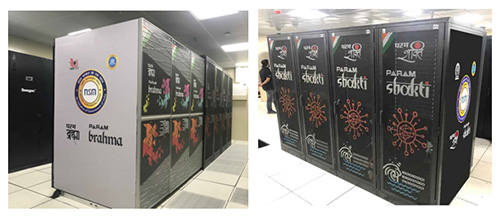 India is fast expanding its supercomputer facilities and developing the capacity to manufacture its own supercomputers in the country.
India is fast expanding its supercomputer facilities and developing the capacity to manufacture its own supercomputers in the country.
The National Super Computing Mission (NSM) is rapidly boosting high power computing in the country through its various phases to meet the increasing computational demands of academia, researchers, MSMEs, and startups in areas like oil exploration, flood prediction as also genomics, and drug discovery.
With the infrastructure planned in NSM Phase, I already installed and much of Phase II in place, the network of supercomputers through the country will soon reach to around 16 Petaflops (PF). Phase III, to be initiated in January 2021, will take the computing speed to around 45 Petaflops.
NSM is jointly steered by the Ministry of Electronics and IT (MeitY) and Department of Science and Technology (DST) and implemented by the Centre for Development of Advanced Computing (C-DAC), Pune and the Indian Institute of Science (IISc), Bengaluru.
Param Shivay, the first supercomputer assembled indigenously, was installed in IIT (BHU), followed by Param Shakti and Param Brahma at IIT-Kharagpur and IISER, Pune, respectively.
Thereafter supercomputing facilities were set up in two more institutions, and one is being set up in Phase I, ramping up high power computing speed to 6.6 PF under Phase-1. In Phase II, 8 more institutions will be equipped with supercomputing facilities by April 2021, with a total of 10 PF compute capacity. MoUs have been signed with total 14 premier institutions of India for establishing Supercomputing Infrastructure with Assembly and Manufacturing in India. These include IITs, NITs, National Labs, and IISERs. Some of these have already been installed, and some more will be done by December this year. The Phase II installations will be completed by April 2021.
Work on Phase III will start in 2021 and will include three systems of 3 PF each and one system of 20PF as a national facility.
The three phases will provide access to High-Performance Computing (HPC) Facilities to around 75 institutions and more than thousands of active researchers, academicians working through Nation Knowledge Network (NKN) - the backbone for supercomputing systems.
HPC and Artificial Intelligence (AI) have converged together. A 100 AI PF Artificial Intelligence supercomputing system is being created and installed in C-DAC, which can handle incredibly large-scale AI workloads increasing the speed of computing-related to AI several times.
The mission has also created the next generation of supercomputer experts by training more than 2400 supercomputing manpower and faculties till date.
Indigenous capability
 Powered by the NSM, India’s network of research institutions, in collaboration with the industry, is scaling up the technology and manufacturing capability to make more and more parts in India. While in Phase I, 30 percent value addition is done in India, that has been scaled up to 40 percent in Phase II.
Powered by the NSM, India’s network of research institutions, in collaboration with the industry, is scaling up the technology and manufacturing capability to make more and more parts in India. While in Phase I, 30 percent value addition is done in India, that has been scaled up to 40 percent in Phase II.
Efforts are being made to design and develop parts like server board, interconnect, processor, system software libraries, storage, and HPC-AI converged accelerator domestically.
India has developed an Indigenous server (Rudra), which can meet the HPC requirements of all governments and PSUs. This is the first time that a server system was made in India, along with the full software stack developed by C-DAC.
Experts said that the pace at which things are moving forward, we may soon have the motherboards and sub-systems manufactured in India, making the supercomputers indigenously designed and manufactured.
Such indigenously designed systems with most parts designed and manufactured in India will be installed at places like IIT-Mumbai, IIT-Chennai, and Inter-University Accelerator Centre (IUAC) at Delhi, C-DAC, Pune, which are covered under Phase III and help move towards supercomputers developed and manufactured totally in India paving the way for self-reliance in the field.






























